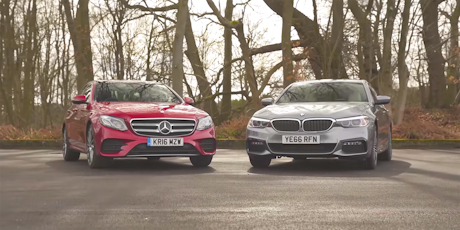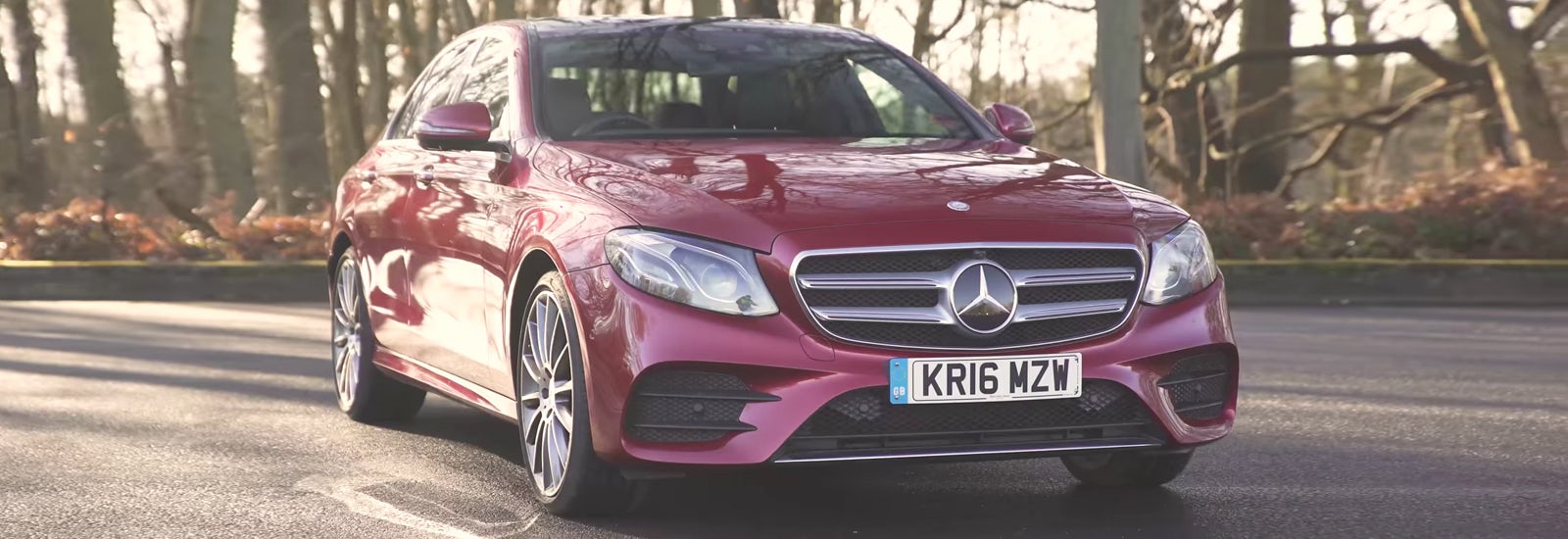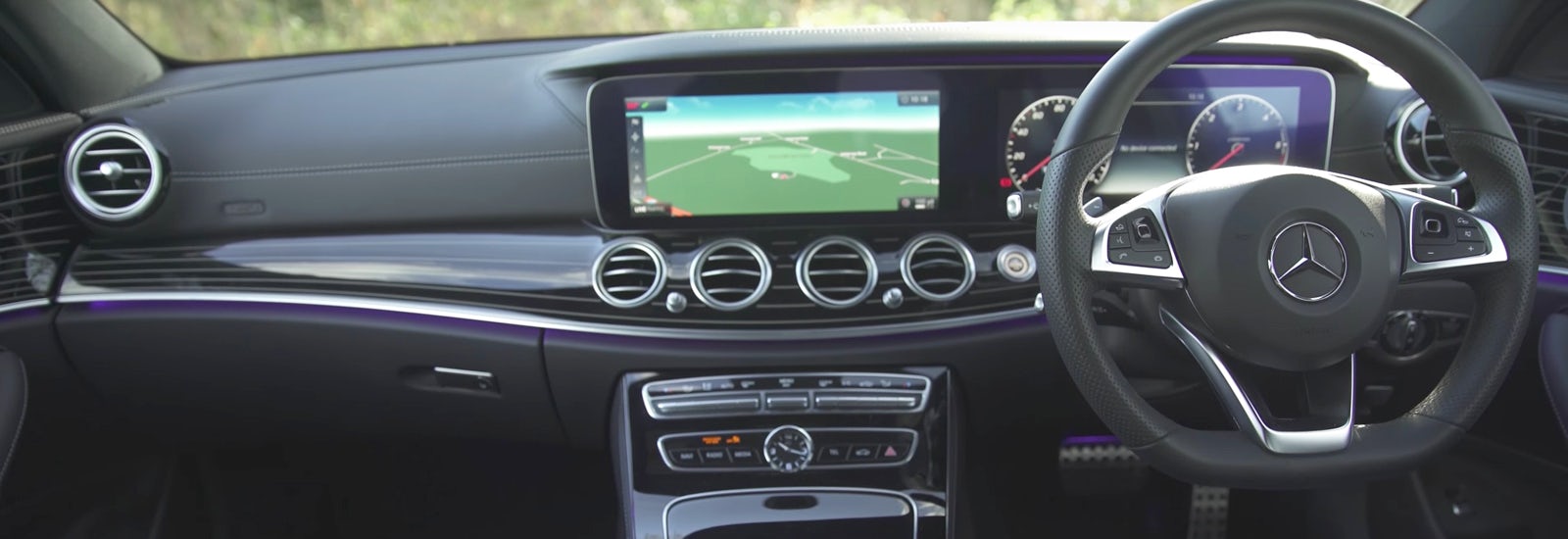BMW 5 Series vs Mercedes E-Class: which is best?
June 29, 2017 by carwow staff

The new BMW 5 Series has arrived. But is it better than the Mercedes E-Class? To find out I put the two premium saloons head-to-head in a series of tests. I’ll compare their design, interior, technology, space and practicality as well as seeing how they both drive. The Mercedes smashed the previous BMW 5 Series in 2016. But will it be able to defend its crown against this all-new 5 Series which actually shares a lot of its parts and technology with the larger, more expensive 7 Series? Read on to find out…

BMW 5 Series vs Mercedes E-Class prices
The BMW 5 Series is priced from £35,835 for the 520i 2.0-litre petrol with an automatic gearbox. The Mercedes, on the other hand, is priced from £35,205 for the E200d 2.0-litre diesel with an auto ‘box. At the time of writing, the Mercedes had incrementally higher average savings than the BMW.

BMW 5 Series vs Mercedes E-Class styling
The BMW 5 Series is well-proportioned with swooping lines and large kidney grilles. However, it arguably doesn’t look as upmarket as the E-Class, even when equipped with the racy M-Sport guise that adds larger alloy wheels and an aggressively styled bodykit.
The Mercedes E-Class is effortlessly beautiful – boasting plenty of ‘wow-factor’, especially with the upgraded 20-inch alloy wheels and with the sporty AMG-Line bodykit. It’s a bit showier than the BMW with the large grille-mounted Mercedes Silver Star and liberal use of exterior silver trim.

BMW 5 Series vs Mercedes E-Class interior
The BMW’s cabin is rather understated when compared with the Mercedes’ aluminium laden interior. Nevertheless, it’s well-built using high-quality materials, features plush leather seats and a smart, simply designed dash. As standard, it features the firm’s top-of-the-range iDrive system – arguably the best infotainment system on the market – offering multiple ways to operate it, including gesture control, a feature allowing you to control infotainment functions by waving your hand in the air. BMW’s digital driving gauges also come as standard on the 5 Series.
The E-Class’s tech-laden cabin is very spacious and features a neat, swooping dashboard that gives it a sense of occasion. However, there are bits of cheap-feeling scratch plastic trim on the interior’s lower parts. The E-Class can be equipped with an upgraded 12.3-inch COMAND infotainment system, along with a 12.3-inch digital cockpit replacing analogue dials – at a cost of £1,990. This system is impressive, however, the COMAND system isn’t as intuitive or as slick as the BMW’s brilliant iDrive system.

BMW 5 Series vs Mercedes E-Class practicality
In terms of practicality, the BMW’s rear seats offer plenty of headroom and legroom for even the tallest of passengers. Unfortunately, a hard and raised centre seat and a hump in the central footwell means that when you fit three abreast, the person in the middle won’t be as comfortable as the other two.
The BMW offers slightly more in-car storage than the E-Class. The BMW’s 530-litre boot is easy to load thanks to a wide aperture – however, it’s trumped by the E-Class in all-out capacity. The boot’s shape isn’t as square as the Mercedes making its space not as usable.
The E-Class is just as comfortable as the BMW in the back, however, it doesn’t boast as much headroom as the BMW. On the other hand, if you have to squeeze three into the rear – the middle passenger will be happier in the Mercedes thanks to a lower, more comfortable centre seat. The Mercedes boot is 10 litres bigger than the 5 Series’ and boasts handy underfloor storage – however, its shape can make loading a bit awkward.

BMW 5 Series vs Mercedes E-Class driving
On the road, the BMW is more fun-to-drive than the Mercedes and behind the wheel, it shrinks around the driver, creating the illusion that is smaller than the car actually is. The 5 Series is surprisingly nimble for a car of its stature – it stays fairly neutral in the corners and its steering is much sharper than the E-Class’. The BMW is arguably on par with the Mercedes in terms of comfort – especially when it’s equipped with £1,000 optional adaptive dampers.
The E-Class wafts its occupants down the road – its driving dynamics favouring comfort over sportiness. Its enormous dashboard conjures images of being at the helm of a big boat rather than that of a premium saloon and it feels more of a sense of occasion when behind the wheel than the BMW.
The ride is serene when equipped with £1,500 optional air suspension, helping it seamlessly glide-along soaking up any imperfection in the road. The trade-off for this comfort is slight body roll in the corners, however, the E-Class isn’t designed with sporty driving in mind.

BMW 5 Series vs Mercedes E-Class engines
The BMW is offered with an extensive choice of engines including frugal diesels, electric variants and sporty petrol choices. The 3.0-litre diesel 530d should be suited most of your needs blending performance and economy – it can dispatch 0-62mph in 5.7 seconds and can return up to a claimed 60mpg.
The entry-level 2.0-litre petrol engine found in the 520i can return up to a claimed 50mpg but feels slightly sluggish when compared to the more powerful 252hp 530i petrol. There’s an environmentally friendly Plug-in petrol-electric hybrid 530e variant that emits 46g/km of CO2 emissions and returns up to a claimed 141mpg. The BMW’s eight-speed automatic gearbox feels more responsive than the E-Class’ – offering crisper and sharper gear changes.
All 5 Series are fitted with the firm’s eight-speed automatic gearbox, that feels more responsive than the E-Class’ – offering crisper and sharper gear changes. BMW’s Xdrive four-wheel drive is available on all diesel models and more powerful petrol models.
The E-Class favours diesel powerplants, reserving petrol motors for its performance E43 and high-performance Mercedes-AMG E63 model. Entry-level E-Classes come equipped with a 2.0-litre diesel unit that’s quicker than the BMW’s equivelent and isn’t as noisy. The E220d should suit most of your needs promising low running costs thanks to a claimed 72mpg and is still reasonably pokey – dashing from 0-62mph in 7.3 seconds.
A low-polluting plug-in hybrid variant, the E350e emits a measly 42g/km of CO2 emissions and can travel solely on electric power alone up to 40 miles and up to speeds of 30mph. This variant is also properly rapid, its combined 282hp output helping it dispatch 0-62mph in just 6.2 seconds.
The Mercedes’ nine-speed auto ‘box is standard across the range and is great at effortlessly blending gears together, however it isn’t as quick-shifting as the BMW’s. Mercedes 4MATIC is available on all but entry-level models.
BMW 5 Series vs Mercedes E-Class verdict
If you looking for an opulent limo the luxurious E-Class will let you roll around in a blend of luxury and comfort. If you’re looking for a premium luxury saloon with a sporty side, the BMW 5 Series will suit your needs. Overall, the BMW just edges the Mercedes as its a bit more of an all-rounder, blending luxury, sportiness and comfort.

Save money on your next car
Click ‘login’ on our homepage to sign up and configure a new car or see our list of new, nearly new, pre-reg and ex-demo cars. Check out our BMW 5 Series deals and Mercedes E-Class deals.















